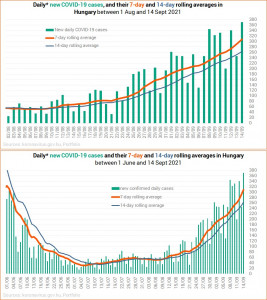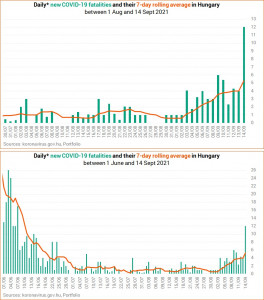Number of COVID-19 patients in Hungarian hospitals match mid-Sept 2020 data

Number of cases keeps on rising
The number of new cases continues to rise, and the 7-day rolling average is already at an early June level.

12 people died of coronavirus-related diseases over the past 24 hours, the same as over a three-day period over the weekend. The 7-day rolling average of COVID-19 deaths has risen further. The situation in this respect is slightly worse than a year ago, when the 7-day rolling average was at around the same level three days later. The trend is not reassuring, though.


Patients in hospital, on ventilator
At the end of the day on Sunday, there were 307 people in hospital with coronavirus infection, 40 of whom required mechanical ventilation. While the number of new cases is smaller than a year ago (about half), there are almost as many people with COVID-19 in hospitals (307 vs. 305), which is alarming. What is even more disconcerting is that there are 40 people on ventilator, against 17 a year ago.
With the vaccines and cross-immunity these numbers should not be this high. There were 700-800 people with COVID-19 in hospital at the end of September last year. Theoretically, there should be half or even less this year, while the halfway mark has not only been hit but exceeded yesterday.
They may say that this is because we are two weeks 'ahead' now, as the number of cases started to rise that much later, but it's not true. The starting point was higher, but the increases started later. For another two to three weeks, we can argue that this is merely because the 'waves' started at different times, but then it will be clear that something has gone awry.


The chart below shows the 7-day rolling averages of COVID-19 patients in hospitals as a percentage of active cases. This is somewhat distorted, at least the plummet you see in the green curve. The recording of active cases does not keep track of the actual number of people with COVID-19, and there were drastic reclassification from active status to recovered. By now, however, there are practically no more people with 'old' active status to reclassify. This is showing in the numbers and has already led to a constant rise in the number of active cases. (Active cases = [Total confirmed cases-Recovered-Deceased].) The other curve shows those on ventilators as a percentage of those in hospitals. This rate has been hovering in range between 14% and 16% for a month, then it started to drop in late August, but now the index is up at 13.2% from 12.1% a week ago and 9.2% a fortnight ago.

The following charts show how the changes of the key hospitalisation figures (l-h) and how the changes have been changing (r-h).

The four charts below show the absolute number of COVID-19 patients in hospitals and on ventilators (top two) as well as two ratios (COVID-19 cases in hospital / Active cases, and COVID-19 cases on ventilator / Cases in hospital, bottom two.) The left-hand charts depict a longer period (15 June - 14 Sept), while the right-hand ones show changes over a shorter period (25 July - 14 Sept).
The ascending trend is crystal clear as regards the number of people in hospital and on ventilator. Sharp increases all over the place.

The charts below show that the percentage of those requiring artificial ventilation of those that are in hospital with COVID-19 dropped some and started to rise again. The drop came about as these people were newly admitted patients, i.e. fewer of them needed mechanical ventilation. It is also on the (r-h) chart, though, that the On ventilator / In hospital ratio is rising faster than the In hospital / Active cases ratio (they are in more severe condition).
Overall, the number of new patients in more severe condition has been rising sharply, and so has the hospitalisation of active cases, and there's an even more dramatic rise in ICU cases, which would eventually lead to more people on ventilators and more deaths than a year ago.

Testing, testing...
Hungarian authorities performed less than 13,000 COVID-19 tests over the past 24 hours. The positivity rate rose to 2.88% from 2.28% a week ago. The 3-day average positivity rate went up to 2.735% from 2.23% a week ago. The 3-day/21-day ratio rose to over 125%, and the 7-day average of the 3d/21d ratio is over 121%.


Vaccine popularity could be better to say the least
Vaccinations continue at a snail's pace. Between 1 August and 14 September:
- 222,500 people got their first dose of a COVID-19 vaccine;
- 109,600 people got their second dose of a COVID-19 vaccine; and
- 544,000 people got their third dose of a COVID-19 vaccine.

And this has been the trend since 1 June.

More than 5.5 million Hungarians are currently fully vaccinated. More than 2.5 million of them received their second dose more than four months ago, while only 20% of them have decided they needed a third dose.
THERE ARE ALSO 2.5 MILLION ADULTS IN HUNGARY THAT HAVE NOT RECEIVED A SINGLE DOSE, AND LESS THAN 10% OF THESE PEOPLE HAVE DECIDED IT MIGHT NOT BE SUCH A BAD IDEA TO GET VACCINATED.
Also note that more than half of those that have received their first dose of a COVID-19 vaccine over the last 44 days are under 18 years of age. It's a fair to imply that these adolescents live in families that are in favour of vaccination. Some of those that got their 2nd dose are also in the 12-17 age group. In view of this, we can state that
THERE ARE FIVE TIMES AS MANY HUNGARIANS ASKING FOR A THIRD DOSE THAN FOR A FIRST ONE.


Cover photo: MTI/Tibor Rosta







